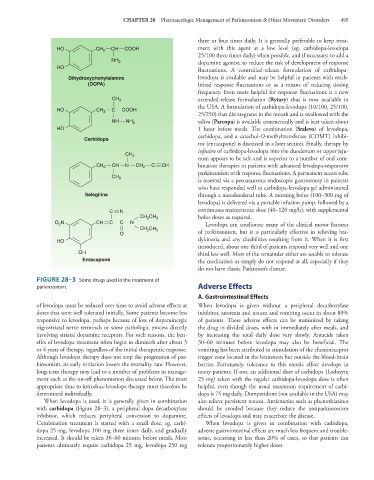Page 509 - Basic _ Clinical Pharmacology ( PDFDrive )
P. 509
CHAPTER 28 Pharmacologic Management of Parkinsonism & Other Movement Disorders 495
three or four times daily. It is generally preferable to keep treat-
HO CH 2 CH COOH ment with this agent at a low level (eg, carbidopa-levodopa
25/100 three times daily) when possible, and if necessary, to add a
NH 2 dopamine agonist, to reduce the risk of development of response
HO fluctuations. A controlled-release formulation of carbidopa-
Dihydroxyphenylalanine levodopa is available and may be helpful in patients with estab-
(DOPA) lished response fluctuations or as a means of reducing dosing
frequency. Even more helpful for response fluctuations is a new
CH 3 extended-release formulation (Rytary) that is now available in
the USA. A formulation of carbidopa-levodopa (10/100, 25/100,
HO CH 2 C COOH
25/250) that disintegrates in the mouth and is swallowed with the
NH NH 2 saliva (Parcopa) is available commercially and is best taken about
HO 1 hour before meals. The combination (Stalevo) of levodopa,
carbidopa, and a catechol-O-methyltransferase (COMT) inhibi-
Carbidopa
tor (entacapone) is discussed in a later section. Finally, therapy by
infusion of carbidopa-levodopa into the duodenum or upper jeju-
CH 3
num appears to be safe and is superior to a number of oral com-
CH 2 CH N CH 2 C CH bination therapies in patients with advanced levodopa-responsive
parkinsonism with response fluctuations. A permanent access tube
CH 3
is inserted via a percutaneous endoscopic gastrostomy in patients
who have responded well to carbidopa-levodopa gel administered
Selegiline through a nasoduodenal tube. A morning bolus (100–300 mg of
levodopa) is delivered via a portable infusion pump, followed by a
C N continuous maintenance dose (40–120 mg/h), with supplemental
2
CH CH 3 bolus doses as required.
O 2 N CH C C N Levodopa can ameliorate many of the clinical motor features
CH CH 3 of parkinsonism, but it is particularly effective in relieving bra-
2
O
HO dykinesia and any disabilities resulting from it. When it is first
introduced, about one third of patients respond very well and one
OH third less well. Most of the remainder either are unable to tolerate
Entacapone the medication or simply do not respond at all, especially if they
do not have classic Parkinson’s disease.
FIGURE 28–3 Some drugs used in the treatment of
parkinsonism. Adverse Effects
A. Gastrointestinal Effects
of levodopa must be reduced over time to avoid adverse effects at When levodopa is given without a peripheral decarboxylase
doses that were well tolerated initially. Some patients become less inhibitor, anorexia and nausea and vomiting occur in about 80%
responsive to levodopa, perhaps because of loss of dopaminergic of patients. These adverse effects can be minimized by taking
nigrostriatal nerve terminals or some pathologic process directly the drug in divided doses, with or immediately after meals, and
involving striatal dopamine receptors. For such reasons, the ben- by increasing the total daily dose very slowly. Antacids taken
efits of levodopa treatment often begin to diminish after about 3 30–60 minutes before levodopa may also be beneficial. The
or 4 years of therapy, regardless of the initial therapeutic response. vomiting has been attributed to stimulation of the chemoreceptor
Although levodopa therapy does not stop the progression of par- trigger zone located in the brainstem but outside the blood-brain
kinsonism, its early initiation lowers the mortality rate. However, barrier. Fortunately, tolerance to this emetic effect develops in
long-term therapy may lead to a number of problems in manage- many patients. If not, an additional dose of carbidopa (Lodosyn;
ment such as the on-off phenomenon discussed below. The most 25 mg) taken with the regular carbidopa-levodopa dose is often
appropriate time to introduce levodopa therapy must therefore be helpful, even though the usual maximum requirement of carbi-
determined individually. dopa is 75 mg daily. Domperidone (not available in the USA) may
When levodopa is used, it is generally given in combination also relieve persistent nausea. Antiemetics such as phenothiazines
with carbidopa (Figure 28–3), a peripheral dopa decarboxylase should be avoided because they reduce the antiparkinsonism
inhibitor, which reduces peripheral conversion to dopamine. effects of levodopa and may exacerbate the disease.
Combination treatment is started with a small dose, eg, carbi- When levodopa is given in combination with carbidopa,
dopa 25 mg, levodopa 100 mg three times daily, and gradually adverse gastrointestinal effects are much less frequent and trouble-
increased. It should be taken 30–60 minutes before meals. Most some, occurring in less than 20% of cases, so that patients can
patients ultimately require carbidopa 25 mg, levodopa 250 mg tolerate proportionately higher doses.

